SPS 2019 Show Exclusive Report

Last November’s SPS automation show in Nuremberg, Germany, was the 30th in the series and the first to drop the previous SPS IPC Drives title, which was always a bit of a mouthful and had outgrown its relevance. The SPS part of the name came from the German equivalent of PLC, but today’s show covers much more than PLCs, industrial PCs and VSDs. It now encompasses all aspects of industrial automation from software and communications to sensors, edge computing and the cloud.
So SPS now stands for Smart Production Solutions. Other than the name, not much has changed. SPS s still the most important dedicated event for the industrial automation sector and the 2019 event attracted 1,585 exhibitors and 63,708 visitors – about 45 fewer exhibitors and 2,000 fewer visitors than in 2018.
The slight drop in numbers perhaps reflects the hard year that the German automation sector experienced, with German trade bodies reporting drops in both orders and sales. Even the normally unstoppable Beckhoff Automation ground to a halt after several years of double-digit growth. But CEO Hans Beckhoff is confident that the tide will turn again this year.

The slowdown in the German economy also perhaps explains why there were few major product launches at SPS 2019 as companies reined in their r&d budgets. The one significant exception was Bosch Rexroth’s revamp of much of its automation portfolio to create a new open platform called ctrlX which uses EtherCat as its main communications backbone.
Areas of technology where there was plenty of activity at SPS included condition monitoring, 5G, digital twins, edge computing, TSN, the cloud and sensing. Over the next few pages, we report on some of the highlights from the show.
MOTORS AND DRIVES
At SPS, ABB demonstrated a cabinet-based regenerative multi-drive system based on its liquid-cooled ACS880LC drives. The system allows several motors to be driven simultaneously or for energy to be partially regenerated, with the feed-in supplying only the differential energy. If an application generates more energy than is being consumed by the motors, then the excess energy can be fed back into the grid. Brake choppers and resistors are not needed.
Allied Motion launched a new range of outer-rotor brushless DC motors supplied as frameless stator-rotor part sets. The KinetiMax HPD motors (Shown below) come in six frame sizes and three stack lengths, and offer low cogging torques, high peak torques, high torque-to-weight ratios, and efficiencies of 83–90% over a wide speed-torque range.

Baumüller was showing a new generation of its b maXX 5300 frequency converters which no longer use plug-in safety modules, but have integrated safety functions instead. The drives support the FSoE (FailSafe over EtherCat) standard, allowing several axes to collaborate safely and to work with higher-level safety controls from various manufacturers. Using resolvers, speed resolutions of less than 1 rpm are possible. When triggering the STO safety function, the controller is switched without torque with a delay of less than 1ms.
Bonfiglioli has added a compact 15kW variant to its Agile series of frequency inverters, designed to be customisable to the application and users’ requirements. It has HVAC functions and can drive asynchronous AC motors or brushless PM synchronous machines.
Delta Line was demonstrating an expanded series of Portescap’s Ultra EC brushless, slotless DC motors in diameters from 16-35mm, with continuous power ratings from 27–330W. There are three variants optimised for parameters such as high speed, high continuous torque, or a balance of speed and torque.
Kollmorgen was showing a second generation of its AKM2G servomotors with higher power densities and more torque from a given size, allowing some machines to use smaller motors. A second generation of Kollmorgen’s AKD2G servodrives offer new safety functions which can avoid the need for I/O modules, saving space.
Maxon motor has a compact new drive that combines its EC-I brushless motor with an EPOS4 positioning controller, with the option of a planetary gearhead. The efficient, IP65-protected IDX drive (below) has configurable analogue and digital inputs and outputs. The EPOS4 is now also available in a micro version (the Micro 24/5) suitable for applications such as robotics where space is tight.

Nord Drivesystems demonstrated its recently announced “IE5+” permanent magnet synchronous motor which can be supplied without a fan and with smooth surfaces. It is said to have much lower losses than IE4 motors, and will be available initially in power ratings from 0.25–1.1kW, with continuous torques from 1.6–4.8Nm, and operating speeds from 0–2,000 rpm. Nord has also improved the design of its IE3 asynchronous motors with optimised fans and fin shapes for better heat dissipation.
Panasonic has developed a 400V servodrive system especially for the European market. The 50mm-wide, bookshelf-format Minas A6 Multi drive can control two axes and is said to use 64% less cabinet space than standard drives. There are 18 built-in safety functions. From mid-2020, there will be matching motors available from 200W–5kW.
Pepperl+Fuchs has developed a purge and pressurisation system for use with large motors or enclosures in Zone 1 hazardous areas. The automated 6100 series system can achieve flow rates of 14,000 litres/min.
SEW Eurodrive has added right-angle and parallel-shaft helical gearmotors (below) to its DCA family of compact, electronically commutated 48V internal rotor motors. There are five new reduction ratios for right-angle gearmotors, while the parallel-shaft motors are an alternative to belt drives.

Siemens announced a portfolio of services that use its new MindSphere Predictive Service Assistance app to make maintenance more efficient for its low-voltage Sinamics drives systems and Simotics motors. It says that services will optimise service cycles, increase service efficiency and streamline documentation.
Siemens also has a new version (v6) of its Sinamics Startdrive commissioning software which now allows the single-axis version of its Sinamics S120 multi-axis drives to be engineered in its TIA Portal engineering environment. The recently introduced Simatic Drive Controller has also been integrated into Startdrive.
WEG presented two extensions to its CFW500 series of VSDs: an IP66-protected version, available in two frame sizes (A and B) spanning motor power ratings from 250W–15kW and voltages from 200–600V in three ranges; and the arrival of a frame size F with rated powers up to 55kW. The new frame is available for output currents of 77, 88 and 105A and voltages from 380–480V, and will open up new applications rated at 37, 45 and 55kW.
WEG has also added a new member to its MW500 family of low-power, decentralised VSDs: a model rated at 370–550W, which means that the series now spans ratings from 370W–7.5kW (280–480V) in three frame sizes, and 370W–1.5kW (200–240V) in one frame size.
CONTROLS
At SPS, ABB launched a second generation of its CP600 touchscreen control panels, available in screen sizes of 8, 10.4 and 15 inches. Two Ethernet interfaces support up to two networks with different physical layers, while a built-in OPC UA server and client protocol means that the HMIs are ready to support TSN connections.
Baumüller introduced a control platform that, it says, bridges the gap between industrial PCs and PLCs. The system is available in two versions: the b maXX PLC mc version is aimed at motion control applications; while the bmaXX PLC IoT version has IoT functions that make it suitable for networked machines and modules down to individual components. Both measure 110 x 90 x 35mm making them much smaller than Baumüller’s previous controllers, and both can implement complex control tasks using IEC 61131-3 programming.
B&R Automation unveiled a new generation of its X20 controllers (below) with the claim that it is one of the first manufacturers to offer OPC UA over TSN communications and to support Intel’s Apollo Lake 1 processors, resulting in cycle times as fast as 100µs. The new controllers can be used a field-level masters and have built-in flash memory. They support up to 250 I/O modules and have faster RAM access and floating point units than the previous X20 controls.
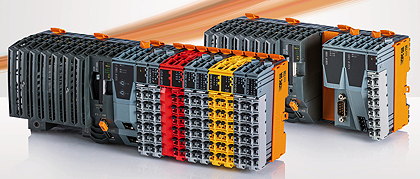
CloudRail announced extensions to its automation technology, launched at the 2018 SPS, which connects with IO-Link sensors and masters via plug-and-play and sends the data to any cloud platform, with configuration taking “less than a minute”. CloudRail has now added an OPC UA connector that can bXV102 touch panele used to query data from any OPC UA device and send it to the cloud. It is also capable of edge computing, pre-processing data locally before sending the filtered data to the cloud.
Eaton has expanded its easyE4 family of control relays to include versions with tool-free push-in terminals for fast installation of control wiring. At SPS, it also announced a colour touchscreen panel (below) for visualising and controlling applications based on easyE4. The 3.5” XV102 panel can be operated even when wearing gloves.

Festo was showing a decentralised I/O system that transmits machine data in real time. The compact CPX-AP-I system can connect up to 500 participants to a main system with cable lengths of up to 50m between modules. The system, which supports IO-Link, provides connections from the field level to the cloud and could be used for applications such as predictive maintenance.
Mitsubishi Electric announced an edge computing system with built-in algorithms for predictive maintenance and quality control. The MELIPC system (below) uses AI (artificial intelligence) to recognise anomalies in machine status in real time. It can improve processes, adapt to variables, and generate live predictive models which can be updated and refined based on new demands from a process.

Panasonic released a series of high-end touchscreen operator panels designed for demanding IIoT applications. The HMx700 series HMIs support touch gestures such as wiping, scrolling and zooming, and are capable of data transfer rates up to 50Mbytes/s.
Pepperl+Fuchs demonstrated an industrial thin client with four DisplayPort connectors, allowing process data to be visualised on up to four Ultra-HD (4K) screens. The BTC14 thin-client boxes are designed for use in harsh conditions.
Phoenix Contact has added a new model to its PLCnext family of open controllers which combine the robustness of a PLC with the openness and flexibility of smart devices. The modular, Profinet-supporting Control AXC F 1152 controller offers a secure connection to Proficloud and acts as a communications hub. It can be programmed using high-level languages.
SEW Eurodrive has extended its Movi C modular automation system by adding further centralised and decentralised components including advanced motion controllers for customised positioning applications. Smart, parameterisable software modules for drive electronics and control technology are said to make complex automation operations easy.
Siemens has launched a new generation of machine-level block I/O devices with IP65/67 protection. The Simatic ET 200eco PN range includes five digital I/O devices and an IO-Link master. They are supplied with power via an L-coded plug with a high current-carrying capacity, allowing longer cables to be used and energy-intensive components to be powered without needing extra supply cables.
Siemens also has a new generation of its Sinumerik CNC system which includes software for creating digital twins. It is said to close the gap between the virtual and the real world and to help reduce development and commissioning times.
Sigmatek was demonstrating a wireless handheld operating panel which allows users to work closely to machines or robots without being encumbered by cables. The HGW 1033-32 panel (below) incorporates a 10.1” multi-touch display as well as three rotary encoders that can be used to operate different axes “almost blindly”. Various safety elements, including an illuminated e-stop, are built in.

Wago has developed a gateway for its universal 750 I/O system that it calls I/O system Advanced. The fast IP20 I/O system is said to result in short reaction times, high signal transmission synchronicity, and the ability to use fast Ethernet buses such as Profinet and EtherCat. In future, it will be possible to integrate protocols such as TSN. Wago has also relaunched its PFC200 controller, pairing it with the new system’s exterior.
Weidmüller has a new IO-Link configurator for its u-control 2000 controller which allows IO-Link devices to be configured and parameterised independently of the network and controller used. As well as an IP20 master module with four individually configurable IO-Link ports, there are two IP67 modules that can be installed close to machines.
Yaskawa is extending its controls range with new versions of its Slio EtherCat CPU 015N and Slio Profinet CPU 015 and 017 that support OPC UA. There is also a free firmware update (v3.0) that adds OPC UA server functions to its Micro M13 and Slio 013 Profinet CPUs. The Profinet CPU family will be joined by the Slio 019 with 3Mb of memory and a built-in Profibus master.
ELECTRICAL AND SAFETY
ABB has upgraded its Slimline XR LV switch-fuse disconnectors and claims to have cut their power losses by up to 35%, from 357W to 230W, thus reducing heat losses and allowing space savings. The disconnectors can link to ABB’s Ability cloud platform. If fuses blow or temperatures or currents exceed set limits, alerts can be issued.
Balluff has developed an inductive coupling system which can transmit 1.7A (40W) as well as IO-Link signals continuously across an air gap. The power capacity is said to be three times higher than other couplers. The bidirectional IO-Link capability can be used to control actuators and valve terminals at the same time as collecting data. In combination with a suitable IO-Link master, almost any fieldbus system can be supported. The image (below) shows the coupler being used in a robot application.
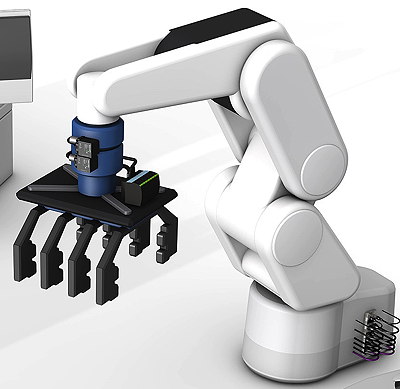
Contrinex has a range of light curtains with a Bluetooth-LE interface that allows remote wireless configuration, and real-time communications of status or diagnostic data to a smartphone or tablet. The YBES curtains do not need safety relays, cutting installation costs. They comply with PL e and SIL 3.
Motortronics, the US motor control specialist that in 2018 acquired the UK soft-start pioneer Fairford, used SPS to launch its new European operation which is offering low- and medium-voltage soft-starts for motors from 1.1kW–15MW. According to the company, the portfolio constitutes “the world’s most innovative and largest range of soft starters”.
Phoenix Contact was showcasing a configurable safety system for applications up to SIL 3 / PL e, with up to 160 safe I/Os. The PSRmodular system (below) uses 22.5mm-wide modules which can be arranged next to each other without configuration on DIN rails. Modules are available to monitor safe motion, e-stops, door locks, light grids and pressure mats. Safety functions can be implemented in accordance with EN 61800-5-2. There is a safe analogue module for monitoring 0/4–20mA or 0–10V signals.

Phoenix also has new power supplies with 40A outputs which it claims are the most powerful available. A single-phase version of the Quint supplies has multi-stage PFC (power factor correction) on the input to optimise efficiency across the power range. Three-phase versions do not generate inrush currents, preventing tripping of backup fuses after short mains breaks.
Rittal was demonstrating a mobile modular wiring table for panel-builders and switchgear manufacturers. The Wire Station 540 is based on an adjustable-height worktable is used to assemble wiring automatically or manually. It is designed to be used in conjunction with Rittal’s automated wire terminal processing machine and ePlan’s Smart Wiring software.
Schmersal launched a slim electromechanical solenoid interlock which can be combined with three different actuators: a straight actuator for sliding doors; an angled actuator for large revolving doors; and a movable actuator for smaller revolving doors. The AZM 150 can deliver an interlocking force of 1.4kN.
Sigmatek is offering a pair of 25mm-wide DIN-rail power modules that can deliver 10A continuous (20A peak) and can be used to control synchronous servomotors. There are two models: the S-Dias DC-101 with a 12-bit resolver input for position detection; and the DC 102 which works with a 32-bit incremental encoder input. 24V DC outputs can control holding brakes.
Wago was showing a range of power supplies in ratings from 120–960W, which can connect to both PLCs and IoT gateways via snap-on comms modules. Data from the Wago Pro 2 supplies can be analysed to optimise energy use, and a central PLC can switch them on or off remotely via hardware signals or bus commands. Efficiencies are up to 96.3%.
WEG has added a new frame size to its SSW900 series of soft-starts, covering the range 480–670A. The starters incorporate PLCs, programmable algorithms for induction motors, protection functions, and flexible torque control. They support star or delta motor connections, as well as string connections, allowing the three motor phases to be wired directly to the thyristor pairs. This means that the soft-start only has to provide 58% of the rated motor current, allowing a smaller device to be used.
WEG has also extended its CWB series of contactors with frame sizes 95, 110 and 125, covering rated operating powers from 45–55kW, 400V, and rated operating currents from 95–125A. There are also new variants: the CWBS contactors for safety applications with rated operating powers from 18.5–37kW; and the CAWBS auxiliary contactors in frame sizes 14–81.
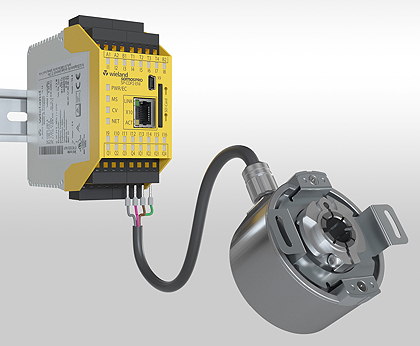
Wieland presented a 45mm-wide safety controller with six basic functions for safe speed, position and direction monitoring. The samos Motion Pro controller (above) incorporates 25 speed-monitoring functions, and can monitor up to 100 speed or position ranges. Ethernet is built in, avoiding the need for a separate gateway. Motion sensors detect pulses up to 70kHz, which the controller converts into speed, angle, position and direction.
MECHANICAL AND LINEAR
Bonfiglioli announced four new ranges of precision planetary gearboxes as part of its Effective line: the compact TQFE series covering 18–155Nm; a right-angle version called TQFEK; the MPE series with a torque range of 5–155NM; and a right-angle version called MPEK.
Bosch Rexroth has extended its ready-to-install MKK (ballscrew) and MKR (toothed belt drive) linear modules upwards with a new 140 size. The modules (below) can be supplied with integrated, non-contact measuring systems and can be connected to central lubrication systems. The belt-drive versions come in lengths up to 9.8m and the ballscrew versions up to 5.4m.
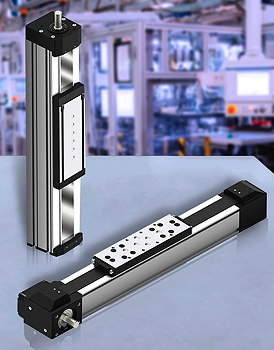
B&R Automation has produced a IP69K-rated washdown version of its AcoposTrak “intelligent” track system which can be pressure-washed at temperatures up to 80°C. The stainless-steel track system is also protected against dust and can be used in both dry and wet areas. The track’s chemical-resistant surfaces prevent particles or fluids from penetrating the interior of the shuttles or segments.
The German brake specialist Intorq claims to be setting new standards for servo brakes with its “revolutionary” BFK518 spring-applied brake which, it says, combines the advantages of spring and permanent-magnet brakes. The compact device is designed to offer holding and emergency-stop functions for servomotors. High braking torques are achieved by using a large friction radius rotor with a small air gap. No setting or axial positioning are required.
The Danish integrated motor specialist JVL announced an integrated linear stepper motor that can deliver a force of 90–900Nm using leadscrew or ballscrew drives. The MIL171/176 motor incorporates control and drive electronics, an absolute multi-turn encoder, and M12 connectors, and supports 12 different industrial Ethernet protocols. Eight I/O points can be configured as digital I/O or analogue inputs.
JVL has also come up with a compact electromagnetic spring brake designed to be mounted on stepper and servo motors with Nema 17 42x42mm flanges. The MAB17 brake will hold the shaft fixed at power-off. When 24V is applied, the brake is deactivated and the motor can turn. The brake has a holding torque of 0.5Nm but higher-torque versions can be ordered.
At SPS, JVL also announced a range of hollow rotary actuators for use with its MAC and ServoStep motors, as well as motors from other manufacturers. The HLMT actuators come in five sizes with flanges from 42–130mm and torque ratings from 5–142Nm.
Maxon motor was previewing a range of zero-backlash, hollow-shaft cycloidal gearboxes prior to their launch planned for April. The high-power-density Cyclo-Flex-Wave gears will come in three diameters (50, 60 and 70mm) and have continuous torque ratings from 4.8–34Nm.
Mayr presented new designs for its Roba-brake-checker module which monitors and supplies safety brakes without needing sensors. The new versions can be used to monitor brakes with torque levels as low as 2Nm. Mayr says this will open up new possibilities for monitoring safety brakes in servomotors and for applications in robotics and automation. The device detects the movements of a brake’s armature disk by analysing the current and voltage it is drawing, and can determine the brake’s condition.
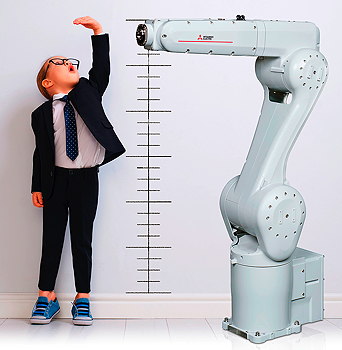
Mitsubishi has produced a cost-effective robot arm with an 8kg load capacity by optimising some of the details of earlier arms. For example, the Melfa RV-8CRL (above) has more than 200 fewer screw connections. As with other Melfa robots, programming is done using the RT ToolBox 3 software.
Moog was promoting precision planetary rollerscrews made by its VSM subsidiary, which can achieve high load ratings and precise positioning, even with small thread pitches. The rollerscrews (below), available on short delivery times, come in screw diameters of 15–100mm, lengths of up to 4m, pitches of 2–42mm, and dynamic load ratings up to 1,250kN (or 3,500kN static). They can accelerate at up to 40m/s2.

Moog is offering a linear actuator based on an inverted planetary rollerscrew with a hollow-shaft rotor that is fitted with a long internal thread with which a roller nut meshes. The MG16331 drive has a sealed push-rod similar to the piston of a hydraulic cylinder. The electrically powered device provides more precise positioning than hydraulic actuators.
At SPS, Schunk announced what it claims is the first long-stroke gripper developed and certified for use with collaborative robots. The Co-act EGL-C devices offers gripping forces up to 450N, a stroke of 42.5mm per finger, and can handle weights up to 8kg. Another arrival on the Schunk stand was an “intelligent” parallel gripper with a certified Profinet-IRT interface. The EGI 80 gripper produces gripping forces up to 100N. Schunk also launched a new generation of rotary mechatronic modules based on a torque motor with an absolute encoder. The compact ERT modules produce dynamic, precise rotational movements.
SENSORS AND MEASUREMENT
Balluff was showing a linear measuring system based on an absolute magnetic encoder with a Drive-Cliq interface that allows plug-and-play use with Siemens controls which detect the sensor and its settings automatically. The BML encoder is designed for absolute position and end-of-travel measurements over lengths of up to 48m, with an accuracy of up to ±12µm and a resolution of 1µm.
Balluff also has a through-beam sensor with IO-Link that offers numerous measuring modes including object diameter and position, gap width and position, edge position, counting and calibration. The 16mm-wide BLA 16C laser light array (below) has a range of 2m and a resolution of 10µm, and can be used without a PC or special software.
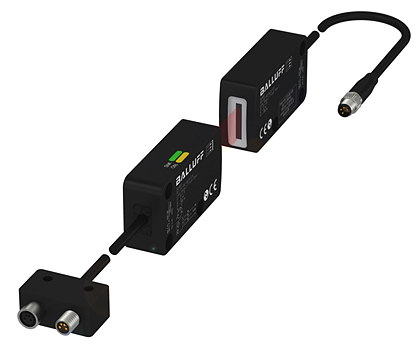
Baumer launched a series of robot vision sensors that can be set up to control Universal Robots cobots within “a few minutes”. The XF900 and XC900 sensors are mounted on the cobot or above it. Calibration of image distortion and co-ordinate alignment take place automatically, eliminating the normal time-consuming hand-eye calibration of robots and vision sensors.
Baumer also announced that 25 cameras in its LX and CX series will support the IEEE 15888 PTP (Precision Time Protocol) standard, allowing precise time synchronisation to 1µs in Ethernet networks. The PTP cameras support synchronisation of images from multiple cameras and simplify the allocation of images to triggers, thus easing system design and integration, especially with multi-camera installations.
B&R Automation is making its Smart Cameras and Smart Sensors available with standard C-mounts, allowing them to be used with C-mount lenses either from third parties or from B&R, which has launched a range of five lenses with focal lengths from 12–50mm.
The Swiss sensor-maker Contrinex was demonstrating a range of “cloud-ready” smart inductive sensors that can be configured via IO-Link to display real-time data on a cloud dashboard. It says that this capability will speed up troubleshooting and reduce downtime, and allow the sensors to integrate with ERP and MES systems.
Contrinex has also added weld-spatter-resistant ceramic coatings to its Weld-Immune series of inductive sensors, increasing their lives.
Datalogic launched a 2 Megapixel resolution sensor for reading 1D and 2D barcodes with a new liquid lens technology that allows the focus to be adjusted electronically. The Matrix 300N 2MP sensor offers various illumination options, including polarised, diffused, red or white lighting to accommodate a wide range of material surfaces.
Datalogic was also showing a new industrial vision processor (the MX-E90) with inputs for eight Power-over-Ethernet cameras, allowing one processor to connect to eight inspection points, cutting the integration, set-up, maintenance, cabinet, cabling and power costs.
Finally, Datalogic announced a new generation of plug-and-play photoelectric sensors with a new Asic custom chip, IO-Link master capabilities and built-in Web servers, for Profinet and EtherNet/IP networks. The first sensor to be upgraded is the best-selling M18 Tubular line which Datalogic says will be the world’s first to offer IO-Link v1.1 and Smart Sensor profiles in a tubular format.
Among a slew of new and enhanced products from Kübler was a space-saving integrated measurement system for asynchronous motors (below), based on bearingless encoders, which is said to set new standards for performance, size and costs compared to bearing-mounted encoders. The system is immune from electromagnetic interference caused, for example, by brakes, and offers smart real-time signal processing that compensates for drift and signal errors.
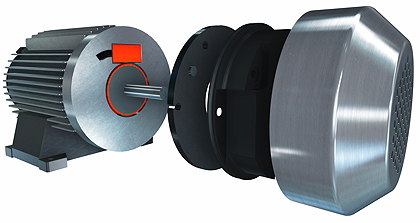
Kübler has also developed a new generation of industrial Ethernet encoders that can be integrated into ProfiDrive and ProfiEnergy networks. The low-profile Sendix F58 Profinet IO encoders offer an isochronous mode for hard real-time applications with clock cycles of less than 1ms.
Also new from Kübler is a 36mm-diameter digital feedback system for servomotors, available in single- and multi-turn variants with resolutions up to 2,048 sine/cosine periods or 24 bits. The Sendix S36 system will allow motor-makers to reduce the number of variants they offer and to standardise mountings between motors and encoders.
LEM announced a range of Rogowski coils for measuring currents up to 300kA which achieve class 0.5 accuracy without needing extra components to calibrate the coil. A “unique” patented coil clasp eliminates inaccuracies caused by the position of conductors inside the loop. The ARU coils (below), available in diameters from 70–300mm, are said to be as easy to install as existing split-core current transformers, but are thinner and more flexible.
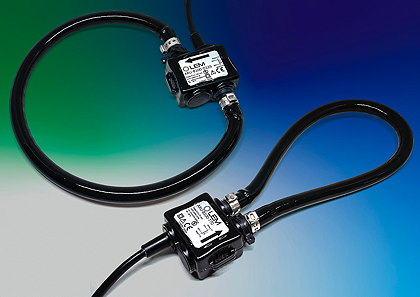
Pepperl+Fuchs presented a new laser-based sensor for 3D object detection that can measure the length, width and height of objects. The 58mm-high R2300 multi-layer scanner achieves an resolution of 0.1 degrees across its 100-degree scanning angle. It has a range of up to 1om on bright objects and 4m on dark surfaces.
The German encoder-maker PWB announced a high-resolution optical scanning head for absolute position detection in tight spaces. Sold as a kit, the ABG-Head consists a single-turn resolution of up to 20 bits at 26mm, in combination with an absolute encoder disc or code strip, which it scans reflectively. SSi, BiSS and SPI interfaces are standard, and others are available.
COMMUNICATIONS
B&R Automation has launched a real-time Ethernet switch that can be used to set up networks using the “vendor-agnostic” OPC UA over TSN protocol. The TSN switch allows cycle times of less than 50µs. It has four real-time capable TSN ports and an Ethernet port, and can be used in star, tree or ring topologies, or daisy-chained, allowing several switches to be cascaded to reach remote cabinets or implement large real-time networks. The X20 form factor takes up little cabinet space and can be mounted next to X20 controls and I/Os. The device can be used as an unmanaged switch in non-real-time networks.
Belden unveiled two next-generation ranges at SPS: Hirschmann managed Bobcat PoE (Power over Ethernet) switches (below), which can supply up to 240W and provide real-time communications through TSN (Time-Sensitive Networking) technology on all ports; and Hirschmann Eagle40 industrial firewalls offering cyber-security functions for automated environments. The firewalls have more port options with increased bandwidth and encryption capabilities, and support both OSPF dynamic routing and VRRP router redundancy.
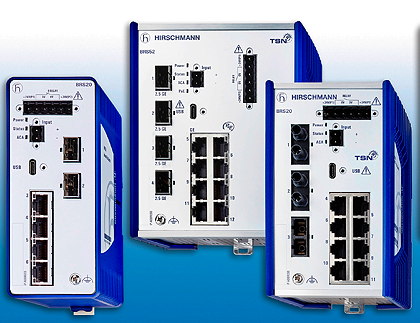
Eaton has bundled its previous IoT offerings to create a single system that includes easy-to-configure gateways in WLAN, LAN and LTE versions, a secure cloud server, and an easy-to-use IoT platform. Called NubisNet, it can be used to analyse and visualise machine data. The platform includes application modules – such as condition monitoring, alarms and energy management – which users can combine to create dashboards using drag-and-drop techniques.
Eaton was also previewing an EtherCat gateway which supports the use of its XN300 I/O system in automation systems based on EtherCat networks. The gateway can also be used with Eaton’s EtherCat-capable XC300 controllers and XV300 touch panels.
HMS Networks revealed a new security platform for its Anybus CompactCom family, adding certificate management and TLS (Transport Layer Security) encryption – initially for the IIoT-enabled versions of the CompactCom Ethernet/IP and Profinet products. HMS also announced a new version of its M2Web service which allows users of its Ewon Cosy and Flexy products to monitor KPIs from remote machines. Enhancements include a new graphical interface, and a map view of all connected machines.
The networking specialist Moxa announced a TSN framework that integrates devices and protocols such as CC-Link IE TSN and OPC UA over TSN. Moxa has cooperated with the backers of those protocols to perform compatibility tests and to bridge devices into an open, interoperable TSN-based environment that facilitates OT/IT convergence, plug-and-produce manufacturing and edge intelligence.
Moxa was also highlighting a series of IIoT edge gateways (below) that it claims are the first Arm-based IoT edge computers certified for use with Microsoft’s Azure cloud platform. Moxa has also formed a joint venture with the cybersecurity firm Trend Micro (called TXOne Networks) that has resulted in three products so far: an industrial intrusion prevention/detection appliance that alleviates the risk of unpatched devices; a firewall with virtual patch capabilities; and a security management software package that enhances the visibility of critical assets.

Panasonic has developed a gateway for Industry 4.0 applications that supports OPC-UA and MQTT and has a built-in Web server and FTP client. The FP-I4C gateway can transmit data from controllers to higher-level systems and provide remote access even for small systems.
Following its acquisition last year of the US-based IO-Link specialist Comtrol Corporation, Pepperl+Fuchs says it is the first company to offer IO-Link masters with OPC UA interfaces. By combining these technologies, P+F adds that it has opened up new possibilities for transparent end-to-end communications from the field level to the cloud.
Phoenix Contact’s PoE (Power-over-Ethernet) injectors now have Atex approval, allowing them to be installed in Ex Zone 2 areas. The injectors can supply 15.4W or 30W in accordance with IEEE 802.3, as well as offering the PoE++ option for supplies up to 80W.
Phoenix’s 2400/2500 family of managed Profinet switches now includes metal-housed versions with downward-facing ports for use in flat control cabinets.
At SPS, Softing presented new Ethernet/IP-to-Profibus gateways (epGate DP, PA and PB) completing its smartGate family, which also supports Profinet and Modbus/TCP. Softing also released version 1.20 of its mbGateDP, PA and PB Modbus/TCP-to-Profibus gateways, adding a “high availability” option that allows the operation of redundant systems with two Modbus/TCP controllers and two gateways, ensuring system availability even if a connection fails.

Weidmüller launched a series of unmanaged, plug-and-play Ethernet switches aimed at smaller networks. The Eco Line switches, with 5–24 ports (above), promise reliable communications between Ethernet-based systems and higher-level networks. They have combinable copper or fibre-optic interfaces. The five-port version is said to be one of the smallest available.
Wieland Electric is offering a range of IIoT starter kits (below) consisting of an IIoT gateway with a built-in IoT PLC and VPN service, a year of cloud access, and a quick-start guide. The gateways have a mobile radio modem, so do not depend on the user’s IT infrastructure. They support Modbus TCP and RTU (via RS-232/485) and have an OPC UA function for transferring data to the cloud. An OPC UA client is planned.

Yaskawa has released an interface that can be used to integrate up to 64 I/O modules from its SLIO system with its Mechatrolink III network. The SLIO 053ML Mechatrolink III interface is said to allow significantly faster signal transmission than Ethernet or Modbus TCP couplings.
SOFTWARE
ABB was demonstrating a new version of its Manufacturing Operations Management (MOM) software suite with extended capabilities including: an enhanced user experience based on a new HTML 5 Web client; a smart interactive dashboard application that provides greater visibility and collaboration; a new SPC (statistical process control) application, to determine if each process is under control; and a new Batch Compare application for advanced batch analyses.
Bosch Rexroth has developed new software for its ActiveShuffle autonomous transport system (below) that, it says, achieves material flow efficiencies that set new standards in intralogistics. The AMS (ActiveShuttle Management System) software provides central control for an entire ActiveShuttle fleet, managing the traffic and assigning transport duties “intelligently”. As well as organising material flows, it also connects with other Rexroth software, such as its Apas production assistant and Active assist worker assistance system.

Baumüller was showing a software package for configuring up to three servo axes in which 80% of the application is pre-configured, reducing development times and allowing new applications to be implemented quickly. The 3 AxisFlex software includes a 3D axis motion library used to implement functions such as collision monitoring, axis group coupling and tool management. An extension called 3 AxisLinear is a ready-to-use package for linear robots that only needs to be parametrised.
The Taiwanese automation specialist Delta used SPS to launch an all-in-one engineering platform for selecting, programming (to IEC 61131-3), setting up and tuning PLCs, HMIs, inverters, servodrives and more. The DIAStudio Smart Machine Suite is said to save time and simplify machine setups. It allows users to “click together” Delta products and their parameters and send the data to a CAD package. The suite includes an app for selecting components on PCs and Android devices. A tool called DIAScreen lets users share tags between PLCs and HMIs or text panels.
Eplan unveiled the latest version (2.9) of its software platform (below). QR codes can be generated quickly that store hyperlinks which can be opened easily on mobile devices in the field. Layers management ensures any changes are saved automatically, making implementing company standards even easier. Projects can be completed faster with mass editing of project data using expanded navigators, and macros can now be re-used easily.
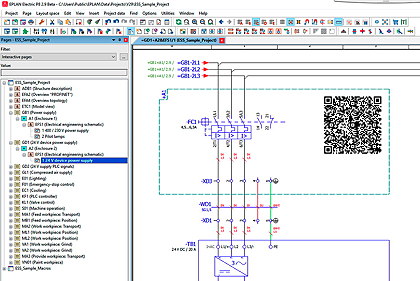
Sick claims that its Installed Base Manager is the first app that allows all of the sensors and machines in an installation to be digitalised, including serial numbers, locations and photos. The app can be used to plan and monitor repair and maintenance activities, and to make documents such as inspection logs, test reports and calibration certificates accessible online.
Another new app from Sick, called Monitoring Box, gives users virtual and real-time access to sensor parameters and events which are shown on a dashboard. It can send notifications if problems arise, while historical data can be used for application-specific predictions to boost plant availability and improve the quality of products and processes.
The next SPS show will take place in Nuremberg from 24–26 November, 2020.





